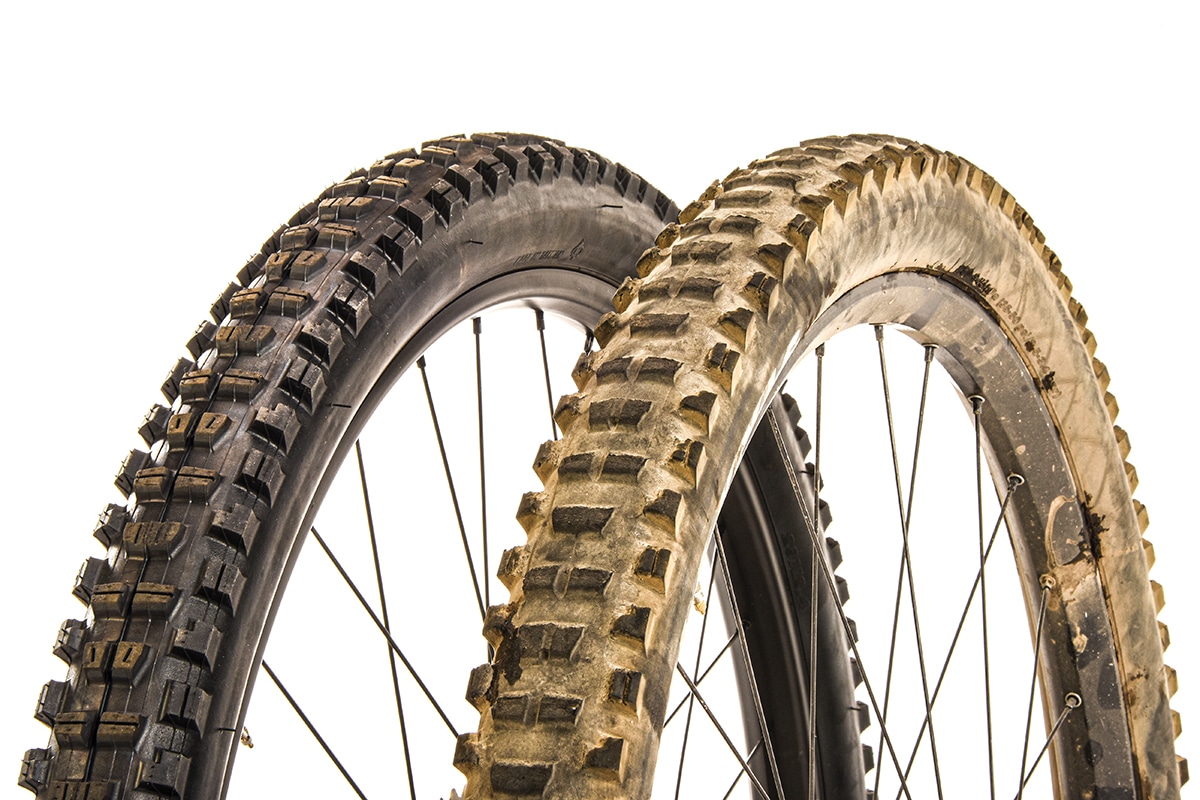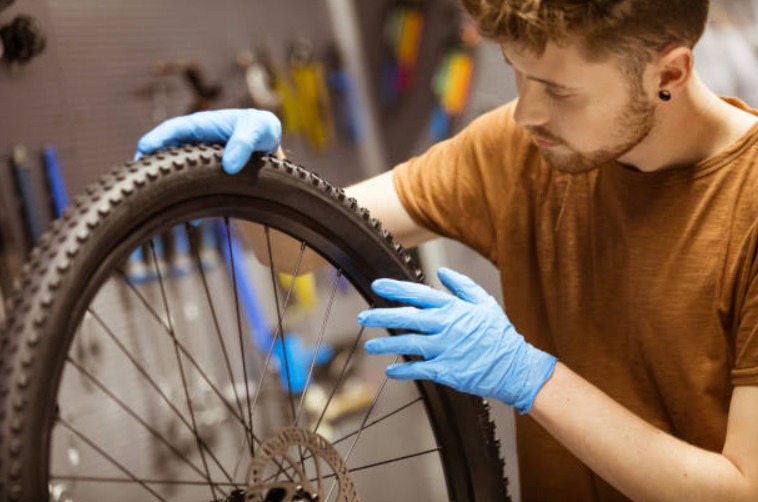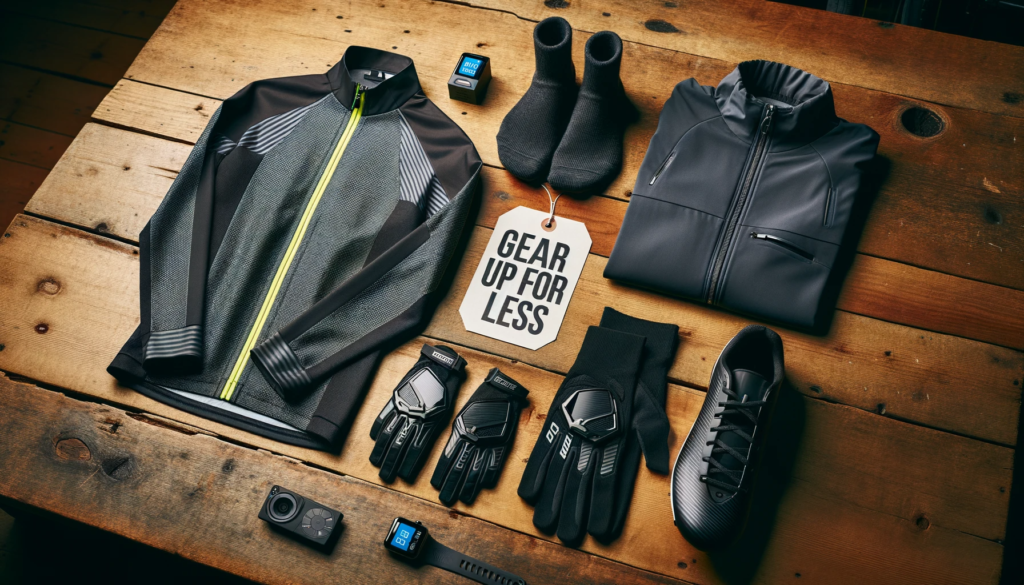Mountain biking is thrilling, challenging, and deeply satisfying. But just like any other part of your bike, your tires won’t last forever.
Knowing when to replace them can make a huge difference in how your bike performs, and how safe your rides are.
You should replace mountain bike tires between 500 and 2000 miles, but the exact lifespan depends on factors like riding conditions, terrain, and tire type.
This guide will walk you through everything you need to know about mountain bike tire replacement. From how long they last to the signs of wear and the types of terrain that affect them, we’ve got it covered.
Why Tire Condition Matters
Your mountain bike tires are the only parts of your bike that touch the ground. They’re your safety net and performance booster. They give you grip, control, and stability on every ride.
Worn-out tires can lead to poor traction, more flats, that can slip on turns, pop more flats, or even put you at risk on tricky trails. So, keeping them in good shape isn’t just about performance, it’s also about safety.
What Makes Tires Wear Out?
Tires don’t wear out at the same speed for everyone. It depends on a few key things. Let’s break them down.
Terrain
Where you ride matters a lot. Hitting rocky, root-filled trails? Your tires are taking a beating—sharp edges can slice them up, and loose gravel grinds them down. On the flip side, smooth, groomed paths are kinder, so your tires last longer.
Riding Style
How you ride plays a huge role too. Love bombing downhills or skidding into corners? That’s awesome—but it chews through tires fast. If you’re more of a chill cruiser, your tires won’t wear out as quickly.
Tire Type
Not all tires are created equal. Some are tough and built to last, while others are made for grip and speed—those tend to wear out sooner. It’s a trade-off between durability and performance.
Weather and Age
Even if you barely ride, time and nature can still get to your tires. Sunlight, heat, and air can break down the rubber over years. So, an old tire might look okay but still be unsafe.
How to Tell If Your Mountain Bike Tires Need Replacing
You don’t need to be an expert mechanic to know when it’s time for new tires. You just need to know what to look for.
1. Tread Wear
The tread is what gives your tires grip. If it’s worn smooth or uneven, it’s time for a change.
- Check for bald spots.
- If knobs are missing or rounded off, that’s a sign your traction is suffering.
2. Sidewall Damage
The sidewalls are thinner than the tread, so they’re more vulnerable.
- Look for cuts, cracks, or fraying.
- If the sidewall is bulging or has threads showing, it’s unsafe to ride.
3. Frequent Flats
If you’re getting flats more often, your tire may be too thin to protect the tube or sealant. This is a common sign that it’s time to replace.
4. Cracking and Dry Rot
Over time, especially if your bike sits unused or is exposed to sunlight, the rubber can dry out and crack. That’s dry rot. Cracked tires can fail suddenly.
5. Loss of Grip
If your bike feels like it’s slipping more often on corners or in wet conditions, your tires may have lost their grip—especially if the tread is worn down.
6. Wear Indicators
Some tires have a cool feature: little bumps or lines in the tread. When you can see them clearly, the tire’s too worn to keep using. Check your tires to see if they’ve got these handy markers.
7. Performance Problems
Feel like your bike’s slipping more? Getting flats all the time? Maybe it’s not handling corners like it used to. These are clues your tires are past their prime.

Credit: mbaction.com
Front Tire vs. Rear Tire Wear
Did you know your rear tire usually wears out faster than the front? That’s because it handles most of the power and weight.
- The rear tire takes the brunt of pedaling force and braking.
- The front tire usually lasts longer but plays a key role in steering and cornering.
A common strategy is to replace the rear tire first and move your older front tire to the back—if it’s still in decent shape. Then, put a new tire on the front where grip is most crucial.
How Often Should You Check Your Tires?
Make it a habit to check your tires before every ride. It only takes a few minutes and could prevent a major problem on the trail.
Look for:
- Low tread
- Cracks
- Sharp objects
- Low pressure
Regular checks help you spot issues early, so you can plan a replacement instead of being stuck in the middle of nowhere.
How Often Should You Replace Them?
Here’s the million-dollar question: how often do you need new tires? It’s not a simple answer, but I’ve got some guidelines.
Mileage Basics
If you ride a lot, plan to replace your tires every 1,000 to 3,000 miles. But that’s just a ballpark—it could be sooner if you’re shredding rough trails or later if you’re taking it easy.
Check Them Often
Don’t just guess—inspect your tires before every ride. Look for cuts or punctures, and make sure the pressure’s right. Catching problems early can save you from a mid-ride disaster.
Bonus Tip: Rotate Them
Here’s a trick—swap your front and rear tires every so often. The rear usually wears faster because it carries more weight. Rotating them helps both tires last longer.
Picking the Right Tires For Your Riding Style
When it’s time for new tires, the options can feel endless. Don’t stress—here’s how to choose.
- Match Your Riding Style: What kind of rider are you? If you’re tearing up trails and hitting jumps, go for tough tires with killer grip. If you’re just cruising, you can pick something simpler and save some cash.
- Think About Terrain: Where do you ride? Muddy trails need tires with big, spaced-out knobs to fling off the gunk. Rocky or hard-packed trails do better with tighter knobs or extra sidewall protection.
- Get the Right Size: Check your bike’s manual or the old tire’s sidewall for the size (like 27.5” or 29”). Getting this wrong messes up your ride, so double-check.
- Rubber Compound: Tires come in soft or hard rubber. Soft ones grip like crazy but wear out fast. Hard ones last longer but might slip more. Pick what fits your style.
- Tread Pattern: Different tread patterns offer varying levels of grip on different terrains. For example, tires with large, deep knobs provide excellent traction on loose and muddy surfaces, while tires with smaller and shallower knobs are better suited for hard-packed trails. Assess your usual riding conditions to determine the tread pattern that suits your needs.
- Tire Width: The width of your mountain bike tire can affect your riding experience. Wider tires offer more stability and traction, especially when riding over uneven or loose terrain. On the other hand, narrower tires contribute to a faster rolling speed and better maneuverability. Consider the balance between stability and speed that you desire.
- Tire Pressure: The tire pressure you choose can significantly impact your ride. Lower pressures provide more traction and absorb bumps better, but they also increase the risk of flats. Higher pressures reduce rolling resistance but may compromise grip. Find the right balance for your weight and riding style.
Overall, it’s crucial to choose a tire that aligns with your skill level, style of riding, and the conditions you frequently encounter. Regularly inspecting and maintaining your tires, regardless of type, will help ensure their longevity and optimal performance.
Putting On New Tires
Got your new tires? Here’s how to get them on.
– DIY or Shop?
If you’re handy, you can swap them yourself with tire levers and a pump. Follow the instructions, and don’t pinch the tube! Not sure? Hit up a bike shop—they’ll do it right.
– Tubeless Option
Tubeless tires are trending—they cut down on flats and let you run lower pressure for grip. But they’re trickier to set up, so you might want help the first time.
– Replace the Tubes Too
If you’re using tubes, grab new ones when you get new tires. Old tubes can pop easier, and fresh ones keep things reliable.
Making Your Tires Last
You can’t stop tires from wearing out, but you can slow it down.
1. Keep Proper Pressure
Running too low on pressure can cause more wear and lead to flats. Too high can reduce grip. Find the sweet spot recommended for your tire type and weight.
2. Avoid Pavement
Mountain bike tires are made for dirt. Riding on asphalt or concrete can wear them down faster.
3. Clean Your Tires
After muddy rides, rinse off dirt and grit. This helps prevent rubber breakdown and lets you spot damage.
4. Look for Damage
Before you roll out, scan for cuts or rocks stuck in the tread. Fix small stuff fast to avoid big problems.
5. Skip the Skids
Skidding looks cool, but it trashes your tread. Try to brake smooth and keep the rubber intact.
6. Store Your Bike Properly
Avoid leaving your bike in direct sunlight or extreme cold. Rubber deteriorates faster in harsh conditions.
Staying Safe
This isn’t just about performance—it’s about keeping you in one piece. Worn tires can blow out or slip on tough trails. If you’re on the fence, replace them. And if a big ride’s coming up, new tires are a smart move—no one wants a flat miles from home.
Why New Tires Rock
New tires aren’t just practical—they’re a game-changer. You’ll feel the difference: better grip, sharper turns, and a ride that feels fresh. If your bike’s been sluggish, this could wake it up.

Credit: www.reddit.com
Terrain Considerations
When it comes to mountain biking, terrain considerations play a crucial role in determining how often you should replace your tires. Rough and rocky trails can wear out tires more quickly, while smoother terrains may not necessitate replacement as frequently.
To ensure optimal performance and safety, regularly inspect your tires for signs of wear and tear and replace them as needed.
Impact Of Terrain On Tire Wear
When it comes to the lifespan of your mountain bike tires, the terrain you ride on plays a crucial role. The type of terrain you frequent can greatly impact the wear and tear your tires endure.
Adjusting Replacement Frequency Based On Terrain
To ensure optimal performance and safety, it is important to adjust the frequency at which you replace your mountain bike tires according to the terrain you ride on. By doing so, you can extend the lifespan of your tires and maximize your riding experience.
Here’s a breakdown of how different terrains can affect your tire wear:
| Terrain | Impact on Tire Wear |
|---|---|
| Rocky trails | High |
| Technical descents | High |
| Rooty sections | Medium |
| Muddy conditions | High |
| Sand or loose surfaces | Medium |
| Hardpack dirt | Low |
| Gravel trails | Low |
| Paved roads | Low |
Based on the terrain you frequently encounter, you can adjust the replacement frequency of your mountain bike tires. Here are some guidelines to consider:
- For rocky trails or technical descents, where tire wear is high, it is recommended to replace your tires every 6 to 12 months, depending on your usage and riding intensity.
- For rooty sections and muddy conditions, which have a medium impact on tire wear, replacing your tires every 12 to 18 months should be sufficient.
- For sand or loose surfaces, where tire wear is also medium, replacing your tires every 12 to 18 months is usually adequate.
- For hardpack dirt, gravel trails, and paved roads, where tire wear is low, you can extend the replacement interval to around 18 to 24 months.
By adjusting the replacement frequency of your mountain bike tires based on the terrain you ride on, you can ensure optimal performance and prolong the lifespan of your tires. Regularly inspecting your tires for signs of wear and tear is also essential in determining when it’s time for a replacement. Remember, a well-maintained set of tires is crucial for a safe and enjoyable mountain biking experience.
DIY Replacement Guide
Proper maintenance of your mountain bike tires is crucial for optimal performance and safety. One essential aspect of tire care is knowing when and how to replace them. In this guide, we will walk you through the step-by-step process of replacing your mountain bike tires at home.
Step-by-step Tire Replacement Instructions
- 1. Begin by loosening the bolts on your wheels using the appropriate tools.
- 2. Deflate the tire completely before removing it from the wheel rim.
- 3. Use tire levers to carefully pry the tire off the rim, starting from one side and working your way around.
- 4. Inspect the inner tube for any damage or wear and replace if necessary.
- 5. Install the new tire onto the rim by pushing one side in first and then working around to fit the rest of the tire.
- 6. Inflate the tire to the recommended pressure level according to your bike’s specifications.
- 7. Tighten the bolts back onto the wheel securely to complete the replacement process.
Tools Needed For At-home Tire Changes
| Tools | Description |
|---|---|
| Tire Levers | For removing the tire from the rim |
| Air Pump | To inflate the new tire to the correct pressure |
| Allen key or wrench | For loosening and tightening the wheel bolts |
Frequently Asked Questions
When Should I Replace My Mountain Bike Tires?
Replace your mountain bike tires when tread is worn, punctures are frequent, or sidewalls show damage. Consider weather conditions and terrain for optimal performance.
How Many Years Do Mountain Bike Tires Last?
Mountain bike tires typically last between 3000 to 6000 miles, depending on usage and terrain conditions.
What Is The Life Expectancy Of A Bike Tire?
Bike tire life expectancy varies depending on factors such as usage, road conditions, and tire quality. On average, a bike tire can last between 1,000 to 3,000 miles or about 1-3 years. Regular maintenance, proper inflation, and avoiding rough surfaces can extend their lifespan.
How Often Should You Replace Bicycle Tires?
You should replace bicycle tires every 2000-3000 miles or when the tread wears down, shows cuts, or bulges. Regularly check for wear and damage. Proper maintenance ensures safety and optimal performance.
Conclusion
Mountain bike tires don’t last forever, and that’s okay. What matters is staying ahead of wear and tear.
Knowing when to replace your tires—and doing it before they cause trouble—means better performance, more fun, and a lot more peace of mind.
So check your tread, inspect those sidewalls, and keep an eye on how your bike feels on the trail. Replace your tires when they start showing signs of age. Your future self will thank you on the next ride




